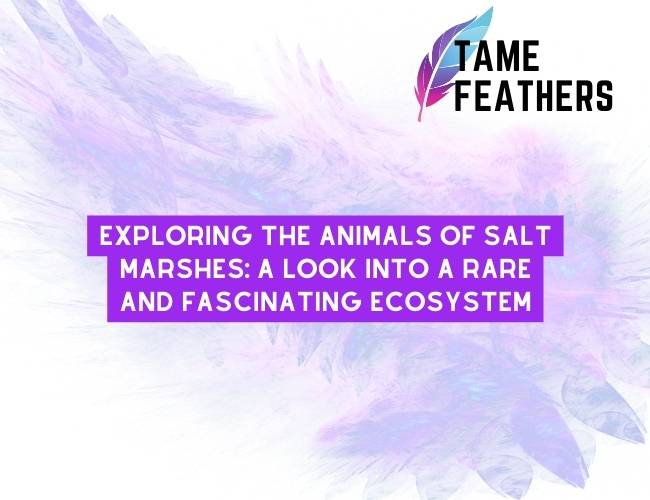Welcome, fellow nature enthusiasts! Are you looking to learn about a rare and unique ecosystem that is home to an array of fascinating animals? Do you find yourself curious about the complex web of life that exists in salt marshes? You’ve come to the right place. In this article, I’ll be sharing my expertise on the topic and giving you a peek into the world of salt marsh ecology. Not only will we explore some of the incredible animals that thrive in these brackish water habitats, but we’ll also take a look at how habitat restoration and conservation efforts are helping protect these vital coastal wetlands. So sit back, relax, and let’s dive into exploring the amazing animals of salt marshes together!
Table Of Contents
Add a header to begin generating the table of contents
Animals That Live In Salt Marshes
Salt marshes are unique ecosystems that are home to a diverse range of animal species that have adapted to the specific conditions of this environment. These animals include crabs, snails, clams, and other mollusks. One of the most iconic salt marsh dwellers is the fiddler crab known for its distinctive oversized claw used for communication and defense. Other animals found in salt marsh habitats include various species of fish such as killifish and striped bass as well as wading birds like egrets and herons.
One key characteristic of many salt marsh animals is their ability to withstand fluctuations in salinity levels due to tidal changes throughout the day. For example, some species like blue crabs can tolerate both high salinity levels during high tide and lower salinities during low tide by taking advantage of osmosis – where they absorb or release water through their gills depending on the surrounding water’s salinity level.
Overall, these highly specialized creatures have evolved over time to thrive in harsh conditions such as frequent flooding from tides, exposure to intense sunlight when waters recede at low tide, and limited oxygen availability depending on tidal cycles.
Salt Marsh Plant Species Overview
Like any ecosystem, plant life forms an essential part of a thriving salt marsh system. Salt-tolerant plants called halophytes grow in areas with varying degrees of saline soil composition ranging from brackish (low-level) up to hypersaline (extremely high-level). The type(s) present depends heavily on local environmental factors such as temperature ranges, rainfall patterns & soil types.
Common examples include cordgrass (Spartina alterniflora), black needlerush (Juncus roemerianus), softstem bulrush (Scirpus validus), sea lavender or Marsh rosemary(Rhizophora mangle), groundsel bush(Baccharis halimifolia).
The Role Tidal Creeks And Coastal Wetlands Play In Salt Marsh Ecosystems
Tidal creeks act like arteries carrying nutrient-rich sediments between upstream freshwater sources out into coastal wetland systems including saltmarshes. These creeks functionally help support healthy habitats by maintaining proper sediment balance which allows more vegetation growth while preventing excessive erosion damage caused by storms & other natural occurrences.
Coastal wetlands play an integral role in sustaining biodiversity within estuarine environments because they serve as nursery grounds for various marine fauna such as shrimp larvae & juvenile fish populations that eventually migrate offshore once mature enough.
Conservation Efforts And Habitat Restoration
As human activity continues expanding into previously undeveloped coastal regions worldwide – habitat fragmentation has become an ever-growing concern facing wildlife conservationists everywhere! Many organizations now focus efforts almost exclusively towards preserving critical ecological zones like saltmarsh ecosystems under threat from development pressures using various methods ranging from purchasing land outright or working with governments / developers directly while also advocating for stronger conservation laws/policies protecting vulnerable lands/animals alike.
Understanding Brackish Water Habitats
Brackish water habitats exist where fresh riverwater enters oceanic systems creating a unique mixture containing elements common among both environments e.g., dissolved salts/sugar compounds/phosphates/nitrates etcetera- resulting often stunted plant growth due primarily reduced light penetration depth caused increased suspended solids content combined generally higher turbidity levels associated with freshwater sources themselves!
The Characteristics Of Estuarine Ecosystems
Estuaries occur where rivers meet oceans forming shallow bays/swamps/mangrove forests/etcetera characterized fluctuating mixtures seawater/freshwater providing ideal breeding grounds certain animal/plant species having developed unique adaptations specifically suited these changing conditions over time.
Threats To Salt Marsh Ecosystems
Many anthropogenic activities threaten fragile ecosystems today including commercial fishing practices causing significant declines numerous commercially important seafood stocks globally; pollution discharge chemical contaminants heavy metals nutrients harmful algal blooms even oil spills all impacting sensitive aquatic/benthic communities living interdependent coexistence beneath surface waters threatened daily!
Adaptations Of Salt Marsh Animals
Animals living within saltmarsh environments must adapt unique physiologies allowing them survive extreme variations water quality/salinity/temperature extremes experienced regularly throughout year! Crustaceans cope desiccation heat stressors via burrowing behavior modified excretory gland secretions helping retain fluids better across membranes enabling thicker cuticles reduced cuticular permeability reduce moisture loss overall!
The Importance Of Salt Marsh Ecosystems
Salt marshes perform vital functions ecological services beneficial humans indirectly overall health planet e.g., carbon storage sequestration combating climate change acting sinks greenhouse gas emissions reducing atmospheric CO2 concentrations; mitigating storm surge impacts shorelines buffering against wave energy promoting stable sedimentation rates locally/global scale.
Exploring The Interconnectivity Of Salt Marshes
Recent studies reveal incredible degree interconnectedness occurring amongst various components within dynamic ecosystem revealing synergistic relationships macro/microscopic flora/fauna alike participate crucial roles maintaining balanced thriving community interactions ultimately responsible productivity resilience observed naturally existing undisturbed landscapes worldwide!
